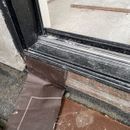Anodized aluminum patio door installed over copper flashing
I’ve seen some similar questions but thought I’d ask my specific issue.
I have a very large Fleetwood aluminum patio sliding door that was installed over copper flashing with no material in between. The bottom of the window track/frame is anodized with a black coating.
We only learned today about the mistake in not using a true barrier between such as bituthane tape. However the stucco has gone on the outside (browncoat only) and the sheetrock and trim on the inside.
It will be very expensive to remove everything and start again. However it looks like we could gently pry up the bottom rail and insert building paper most of the way back. Or another material (not sticky, that won’t be able to slide under).
This area gets a lot of rain in the winter but is dry for several months (N California).
Question is, can anyone say with any certainty what kind of problems to expect in 5, 10, 20 years? Of course it will be cheaper to address it now while the contractors are still at the jobsite etc. But still a few $K and more delays.
Thank you, community 🙂
GBA Detail Library
A collection of one thousand construction details organized by climate and house part










Replies
None expert opinion, but I think it will be better to sort this issue now by removing and reinstalling the slider.
Typically a door would be set in sealant on top of the flashing, which could be separating the materials, and would prevent the easy insertion of another material. I would expect the contractor to follow the manufacturer's instructions for installation, such as the bed or beads of sealant. If they did not, then they should reinstall the door correctly for no extra charge.
You'll get galvanic corrosion, which is just a fancy way of saying that the aluminum will rot out more quickly due to dissimilar metals acting like small battery.
All you need is an interface material between. Sometimes this is stainless steel, but in most cases it's some kind of electrically insulating material like the tape you mentioned. For a retrofit, you might try rigid HDPE sheet to see if you could slip it in between existing, installed, materials. I've never tried this though, so I don't know how well it would work.
The anodized coating will actually provide some protection, but any scratches are places where corrosion will start. It's difficult to really say how bad of an issue this might be in the future, but I would try to do as much as you can to remedy the problem now.
Bill
With certainty? No. The amount of moisture and salt involved, the quality of the anodized coating and the thickness of the aluminum (the anode) all play a part. Here on the Maine coast, it might last 5-10 years. If you're inland and there is a decent roof overhang, it might last for decades. But since failure means replacing the door and possibly water damage as well, it probably make sense to bite the bullet and reinstall the door before you get farther along.
Thank you so much for your replies, it's been very helpful!